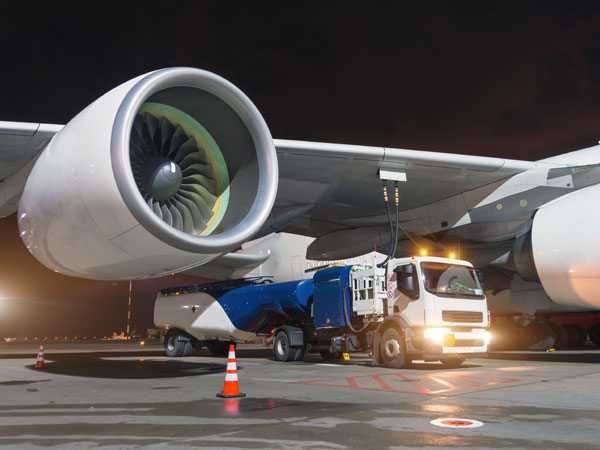The Nordic region can make aviation more sustainable by collaborating on a funding mechanism for renewable fuels financed by common passenger taxes.
In January 2019 the Nordic prime ministers signed a declaration on a common Nordic vision for carbon neutrality and particularly committed their countries to strengthening mutual co-operation in order to achieve carbon neutrality in the transport sector.
A new TØI report outlines a number of recommendations for a common Nordic approach to promoting more sustainable aviation in the Nordic region. The report concludes that the Nordic region can make air traffic more sustainable by collaborating on various strategies, not least implementing a funding mechanism for renewable fuels (sustainable aviation fuels, SAFs) and other strategies to decarbonize the sector financed by common Nordic passenger taxes.

A new TØI report outlines a number of recommendations for a common Nordic approach to promoting more sustainable aviation in the Nordic region.
Photo: Shutterstock
Political commitment a contributing factor to sustainable aviation
Air transport of persons and goods has been steadily increasing in most parts of world in recent decades, including the Nordic countries, and accounts for a small, but rapidly rising, share of the world’s CO2 emissions. That is, before the Covid-19 pandemic created a radical reduction of air transport globally.
As of today, all forms of production of sustainable aviation fuels are far more expensive than fossil fuels, and global production is limited. A political commitment to implement a set share of SAFs in the Nordics by 2030 combined with a funding mechanism that bridges the cost gap between conventional jet fuel and SAFs can accelerate the development of sustainable aviation fuels by creating real demand and reducing investor risk.
Regardless of which strategies chosen to reduce greenhouse gas emissions in aviation at the Nordic level, like using sustainable aviation fuel and / or zero-emission technologies such as battery-powered aircraft, clear signals of political commitment will help reassure investors and other stakeholders without favoring one technological path over the other. At the strategic level, this can be done by formulating a common Nordic vision for sustainable aviation supported by an ambitious common goal for renewable energy in aviation by 2030. In addition, Nordic co-operation, e.g. by a joint financing scheme/similar national financing schemes, are likely to have potential benefits beyond the sum of unilateral measures.

Photo: Shutterstock
Policy recommendations for a joint initiative
The report presents four overall policy recommendations for a joint Nordic initiative to promote sustainable aviation fuel:
- Supply side measureswith a long-term perspective are needed to promote sustainable aviation. In a 2030 perspective, this will in practice mean pushing for a gradual increase to a significantly higher share of SAF of total jet fuel consumption.
- Demand side measures in terms of increased taxation can remedy excessive air travel from under-taxation of aviation both compared to its climate impact and to other consumption, especially road transport. However, national or Nordic taxes alone are not likely to lead to a profound leap forward toward sustainable aviation over the next decade under existing international regulations.
- A SAF fund combined with an ear-marked passenger tax on all aviation in the Nordics may both minimize carbon leakage from tankering and provide financing mechanism for the additional costs of a significant share of SAF in total jet fuel consumption.
- A common Nordic policy frameworkconsisting of a joint Nordic (or parallel national) SAF fund(s) financed by harmonized Nordic passenger taxes can secure demand for significant and stable volumes of SAF toward 2030. A joint Nordic long term commitment will enhance opportunities for large-scale production by reducing investor risks.

Photo: Shutterstock
If the Nordic countries agree to proceed in line with the proposed approach outlined above, the next step in the preparation of concrete joint initiatives may be:
- Establish a SAF fund/SAF funds. Conduct a juridical assessment of alternative models for construction of a Nordic or parallel National SAF fund(s), especially which financing mechanisms would be in accordance with the EU’s state aid regulation. Elaborate the detailed design of the financial support mechanism a SAF fund, including sustainability criteria for eligibility of SAF.
- Passenger taxes. Nationally implement harmonized passenger taxes in each Nordic country, taking into consideration the size and structure of existing and expected passenger taxes in neighboring European countries.
- Electric aviation. Politically adopt a common Nordic commitment to pursue the potentials of electric aviation.
- RD&D. Finance a common Nordic research and innovation program for SAF and electric propulsion.
- International cooperation. Form a united position in EU and international fora pleading for EU-wide GHG taxation of fossil jet fuel or alternatively a wider scope for national implementation of distance-based passenger taxes.
The report is prepared by the Institute of Transport Economics, commissioned by Nordic Energy Research and funded by the Nordic Council of Ministers.
You can read a summary of the report here
Text: Hanne Sparre-Enger, TØI
 Contact:
Contact:
Niels Buus Kristensen
nbk@toi.no
TØI Institute of Transport Economics, Norway






Follow us: